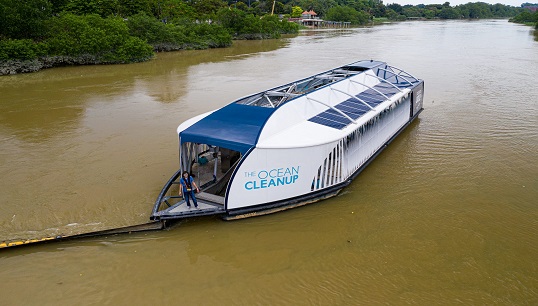Turning off the garbage tap: the next step in Ocean Cleanup's mission to eradicate waste plastic from the sea
2 September 2021

An environmental organisation best known for tackling the Great Pacific Garbage Patch has found a way of stopping waste plastic in rivers from reaching the sea. Saffiyah Khalique reports
Rivers are the main source of ocean plastic pollution, with 80% of this waste stemming from 1,000 rivers, according to research carried out by not-for-profit organisation Ocean Cleanup.
Having developed and installed its floating waste collection system in the Pacific – with help from Nautilus members at Boskalis and Maersk – the organisation has now turned its attention to preventing discarded plastic from reaching the sea in the first place.
Using a new vessel type called the Interceptor, Ocean Cleanup aims to tackle plastic in 1,000 rivers over five years by working together with government leaders, individuals, and private corporations. The vessel is 100% solar-powered and able to extract plastic autonomously from the majority of the world's most polluting rivers, as well as having full internet connectivity, allowing for the collection of performance data and communications with shore staff.
The organisation has worked with governments and local operators to determine where best to set up the Interceptor by taking into consideration the width of the river, flow-velocity, presence of plastic and traffic. Under optimal conditions, the Interceptor can extract 50,000kg of plastic per day, and with the vessel being autonomous, it is able to operate 24/7.
Currently there are Interceptors placed in the Cengkareng Drain in Jakarta, Klang River in Malaysia and Rio Ozama in the Dominican Republic.
How does the Interceptor work?
The Interceptor uses a range of collection and storage equipment to capture the plastic waste in the river and bring it to shore for recycling and responsible disposal:
Barrier – river waste flowing with the current is guided by the barrier towards the opening of the Interceptor and due to the catamaran design of the vessel, the water flow path is optimised to pass through the system carrying the plastic onto the conveyor belt.
Conveyor belt – the current moves the plastics onto the conveyor belt, which continuously extracts the debris from the water and delivers it to the shuttle.
Shuttle – a shuttle automatically distributes the debris across six dumpsters with the use of sensory data. The containers are filled equally until they reach full capacity.
Dumpsters – the Interceptor can store up to 50m³ of garbage before the dumpsters need to be emptied.
Empty and recycle – when the Interceptor is almost full, it automatically sends a text message to the local operators to come and collect the waste. The operators then remove the barge and bring it to the side of the river, emptying the dumpsters and taking the rubbish to local waste management facilities ready for the vessel to return back to operation.
The cost of plastic pollution
From research published in its 2020 article Predicted Growth in Plastic Waste Exceeds Efforts to Mitigate Plastic Pollution, Ocean Cleanup estimates that between 24 and 35 million metric tonnes of plastic waste is entering the aquatic environment on an annual basis. This is harming marine life and also has an economic cost, which Ocean Cleanup calculates as $150 million a year in the UK and $47 million in the Netherlands. In the UK, $120 million of this cost affects the tourism sector, but in the Netherlands the main problem lies with fisheries and aquaculture, where the consumption of microplastics by farmed and wild sea creatures leads to substantial losses in reserves, harvest and income.
In a post on the Ocean Cleanup website, the organisation's founder and CEO Boyan Slat says plastic use will not stop growing any time soon – referring to a Goldman Sachs prediction that the annual growth of plastic consumption will continue well into the 2040s. This underlines the need for the adoption of high-quality waste management systems like the Interceptors.
The aim is to move towards a closed-loop system with financial incentives to drive collection and new recycling methods where the quality material is not lost. The management of waste aluminium is a good model of economic viability, as reusing this material is cheaper than producing new aluminium and the recycled material is as good as new.
However, Mr Slat acknowledges that it is going to take a very long time before a similar situation could be achieved for plastics, so responsible waste management systems have to be the main solution in the short to medium term.
'To truly rid the oceans of plastic,' he stresses, 'we need to both clean up the legacy and close the tap, preventing more plastic from reaching the oceans in the first place. Combining our ocean cleanup technology with the Interceptor, the solutions now exist to address both sides of the equation.'
Find out more about the Ocean Cleanup and follow the progress of the Interceptor vessels via @TheOceanCleanup on Twitter.
Tags
